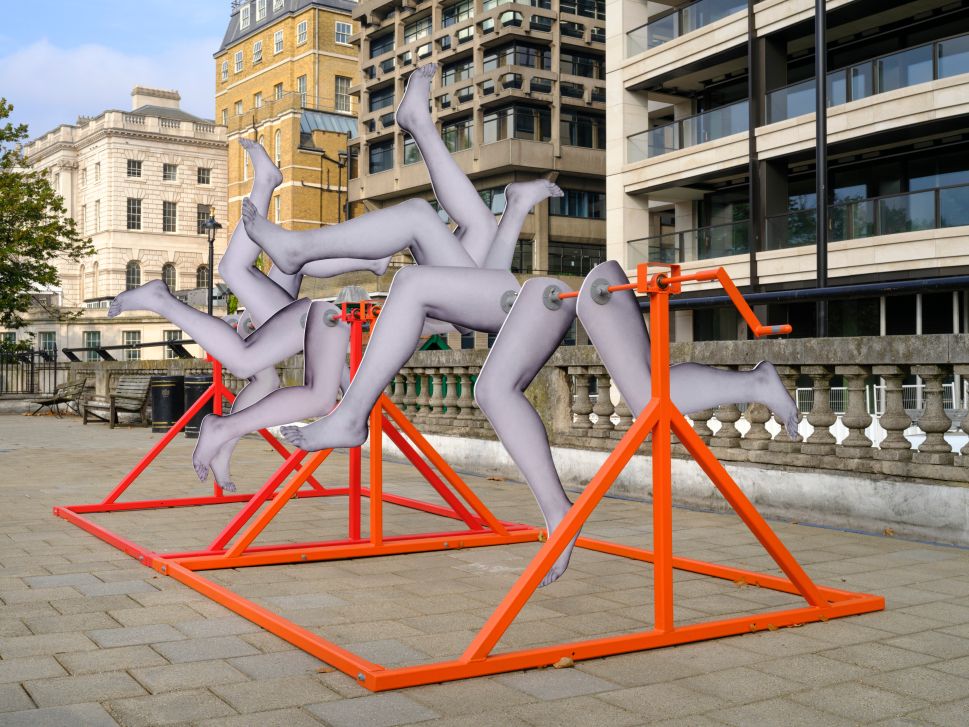
If public art is a cool way of starting conversations, Central London is becoming quite the chatterbox. From Ian Davenport’s Poured Lines (the U.K.’s largest outdoor painting) under a bridge in Southwark to the merry-go-round of artwork on the Fourth Plinth in Trafalgar Square and the huge digital art screens in Tottenham Court Road, the place is turning into a buzzing, busy art walk. Relatively new to the chat is The Artist’s Garden. Opened in 2021 in a blank space above the Temple underground station, the Garden is a slab of prime real estate that fits naturally into a stroll along the River Thames. Entrance is free and, most importantly of all, The Artist’s Garden is the world’s only public art garden focused on work by women.
The Garden was inaugurated with London artist Lakwena’s dizzyingly colorful Back In the Air, a mosaic that covered the area’s entire 1,400 square meterage. Through the Cosmic Allotment followed in 2022, Tony Heywood and Alison Condie’s collection of greenhouses containing psychedelic sculptural shapes. For the following year, installation artist Holly Hendry created Slackwater, a huge tangle of metal pipes inspired by the moment a river’s tidewater turns. This year’s “MARY MARY” is The Artist’s Garden’s first group exhibition and features three-dimensional work by Rong Bao, Olivia Bax, Lucy Gregory, Virginia Overton, Candida Powell-Williams, Frances Richardson, Holly Stevenson, L R Vandy and Alice Wilson. The exhibition’s title comes from the nursery rhyme that wonders, “Mary, Mary, quite contrary. How does your garden grow,” rejecting entrenched views of female contrariness while showing just what can happen when women take control of traditionally male-dominated art spaces.

London-based artist L R Vandy’s work addresses female inequality, in life and in art. She has two pieces on show here. Dancing in Time: The Ties that Bind Us is a smaller version of an artwork that formed part of the International Slavery Museum’s MLK pop-up series in Liverpool in 2023. Made from plaited ropes and woven reeds, the piece addresses enslavement and the origins of spirit dances from the African diaspora. Superhero Cog-Woman is a candy-colored stack of imposing industrial cogs that’s an homage to nearby Waterloo Bridge (known colloquially as Ladies’ Bridge), which is said to have been built by women welders during the Second World War.
SEE ALSO: Painter Pam Evelyn On Making Her New York Debut with ‘Frame of Mind’
At first glance, Rong Bao’s Yellow Path looks like a set of domino pieces or Lego bricks laid end to end. Closer inspection reveals the raised flat circles are Braille characters, and Bao has created a square, infinite path of tactile mats that reflect the Braille-embossed paving stones used in Beijing to aid visually impaired pedestrians. The Braille spells out a poem by Alex Donnelly commissioned specifically for the piece.




Olivia Bax’s Cartouche consists of a box with connected metal bars, as well as a teapot and a bowl. It looks a little homespun, but maybe that’s the point. Virginia Overton’s Untitled (chime for Caro) is a giant set of wind chimes made from metal pieces discarded by sculptor Anthony Caro from his work at the Yorkshire Sculpture Park. Caro left the pieces for other artists to use, and The Artist’s Garden rings out with cacophonous clangs as visitors bang and push the pieces about. Frances Richardson adds wheels and a bundle of discarded fabric to an existing bench to draw attention to homelessness for Performed Object, and Holly Stevenson’s Another Mother replaces one of the space’s original, lost wall parts with her own surreal ceramic version. Taking its name from the nearby hotel, Alice Wilson’s Savoy is two bundles of tall, brightly painted wood that sway pleasingly in the Autumn breeze. Candida Powell-Williams’ Auguries through the Mist is a hodgepodge. There’s a pinkish orb (or possibly an egg) covered in Jesmonite flowers and human limbs. Four blue feet supporting a cage sit on the egg/orb. There’s also a kind of blue chain and some other bits and bobs strewn around, and the whole caboodle is piled onto a four-wheeled bowl-shaped cart. Oh, and




Leading the field in the conversation stakes, though, is Lucy Gregory’s It’s All Kicking Off. Picture a long vertical pole with flattened images of female legs attached and handles at either end. Turn the handles, and the pole and legs spin and rotate in a crazed, freewheeling version of the can-can. The artwork is a comment on Victorian values, specifically how women were frowned upon for showing an ankle beneath their long crinolines and petticoats. It’s All Kicking Off is a riot.
It’s both remarkable and sad that The Artist’s Garden exists. Remarkable because, of course, it’s essential to break new ground and give women artists the space they so richly deserve. Sad because, well, why aren’t there more spaces like this? Either way, while “MARY MARY” might not be one of the most important group exhibitions ever, it’s a perfect family friendly intro to public art, melding interactivity, socio-political messaging and jolly good fun.
“MARY MARY” is on through September 3, 2025, at The Artist’s Garden above the Temple underground station, London. Entry is free.





